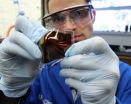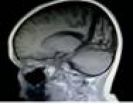(Press-News.org) Nanoengineers at the University of California, San Diego are asking what might be possible if semiconductor materials were flexible and stretchable without sacrificing electronic function?
Today's flexible electronics are already enabling a new generation of wearable sensors and other mobile electronic devices. But these flexible electronics, in which very thin semiconductor materials are applied to a thin, flexible substrate in wavy patterns and then applied to a deformable surface such as skin or fabric, are still built around hard composite materials that limit their elasticity.
Writing in the journal Chemistry of Materials, UC San Diego Jacobs School of Engineering professor Darren Lipomi reports on several new discoveries by his team that could lead to electronics that are "molecularly stretchable."
Lipomi compared the difference between flexible and stretchable electronics to what would happen if you tried to wrap a basketball with either a sheet of paper or a thin sheet of rubber. The paper would wrinkle, while the rubber would conform to the surface of the ball.
"We are developing the design rules for a new generation of plastic--or, better, rubber--electronics for applications in energy, biomedical devices, wearable and conformable devices for defense applications, and for consumer electronics," said Lipomi. "We are taking these design rules and doing wet chemistry in the lab to make new semiconducting rubber materials."
While flexible electronics based on thin-film semiconductors are nearing commercialization, stretchable electronic materials and devices are in their infancy. Stretchable electronic materials would be conformable to non-planar surfaces without wrinkling and could be integrated with the moving parts of machines and the body in a way that materials exhibiting only flexibility could not be. For example, one of the chief applications envisioned by Lipomi is a low cost "solar tarp" that can be folded up for packaging and stretched back out to supply low cost energy to rural villages, disaster relief operations and the military operating in remote locations. Another long-term goal of the Lipomi lab is to produce electronic polymers whose properties--extreme elasticity, biodegradability, and self-repair--are inspired by biological tissue for applications in implantable biomedical devices and prosthetics.
Lipomi has been studying why the molecular structures of these "rubber" semiconductors cause some to be more elastic than others. In one project published recently in the journal Macromolecules, the Lipomi lab discovered that polymers with strings of seven carbon atoms attached produce exactly the right balance of stretchability and functionality. That balance is key to producing devices that are "flexible, stretchable, collapsible and fracture proof."
Lipomi's team has also created a high-performance, "low-bandgap" elastic semiconducting polymer using a new synthetic strategy the team invented. Solid polymers are partially crystalline, which gives them good electrical properties, but also makes the polymer material stiff and brittle. By introducing randomness in the molecular structure of the polymer, Lipomi's lab increased its elasticity by a factor of two without decreasing the electronic performance of the material. Their discovery, published in RSC Advances, is also useful for applications in stretchable and ultra-flexible devices.
INFORMATION: END
Nanoengineers develop basis for electronics that stretch at the molecular level
2014-05-05
ELSE PRESS RELEASES FROM THIS DATE:
Minneapolis Heart Institute Foundation implants its 1st world's smallest cardiac pacemaker
2014-05-05
MINNEAPOLIS, MN – May 1, 2014 – The Minneapolis Heart Institute Foundation (MHIF) announced today the first implant of the world's smallest pacemaker at the Minneapolis Heart Institute. The device was implanted as part of a global clinical trial and the procedure was the first of its kind in the Midwest.
One-tenth the size of a conventional pacemaker, and comparable in size to a large vitamin, the Medtronic Micra™ Transcatheter Pacing System is delivered directly into the heart through a catheter inserted in the femoral vein. Once positioned, the pacemaker is securely ...
Penn study shows stimulant drug may help women cope with post-menopausal memory lapses
2014-05-05
NEW YORK – Menopausal women have long reported experiencing hot flashes, mood swings, night sweats and memory lapses, too.
A new study from researchers in the Perelman School of Medicine at the University of Pennsylvania shows preliminary evidence that the psychostimulant drug lisdexamfetamine (LDX) can aid post-menopausal women by improving attention and concentration, organization, working memory and recall. The findings will be presented by C. Neil Epperson, MD, director of the Penn Center for Women's Behavioral Wellness, on Tuesday during the American Psychiatric ...
Inbred wolves struggle, moose proliferate at Isle Royale National Park
2014-05-05
During their annual Winter Study at Isle Royale National Park, scientists from Michigan Technological University counted nine wolves organized into one breeding pack and a second small group that is a remnant of a formerly breeding pack.
In the Isle Royale Wolf-Moose Study’s annual report released today, the researchers say that over the past three years, they have tallied the lowest numbers of wolves ever: nine in 2011–12, eight in 2012–13 and nine in 2013–14. During the same period, predation rates—the proportion of the moose population killed by wolves—also dropped ...
Infusion of young blood recharges brains of old mice, Stanford study finds
2014-05-05
STANFORD, Calif. — Something — or some things — in the blood of young mice has the ability to restore mental capabilities in old mice, a new study by Stanford University School of Medicine investigators has found.
If the same goes for humans, it could spell a new paradigm for recharging our aging brains, and it might mean new therapeutic approaches for treating dementias such as Alzheimer's disease.
In the study, to be published online May 4 in Nature Medicine, the researchers used sophisticated techniques to pin down numerous important molecular, neuroanatomical and ...
Compound Formula Rehmannia alleviates dyskinesia in Parkinson's disease
2014-05-05
Levodopa is the preferred treatment for Parkinson's disease in the clinic. However, long-term use of levodopa may lead to various motor complications, among which levodopa-induced dyskinesia is the most common, severely affecting patients' quality of life. Dr. Jiancheng He and co-workers from Shanghai University of Traditional Chinese Medicine in China established a model of Parkinson's disease dyskinesia in rats, and treated these animals with Compound Formula Rehmannia. They found that Compound Formula Rehmannia alleviates levodopa-induced dyskinesia in Parkinson's disease ...
New idea for hearing improvement in patients with hearing aids under background noise
2014-05-05
Patients with implanted artificial cochlea often complain that they cannot recognize speech well in natural environments, especially if background of noise is present. Researchers think that a poor ability to localize sound in a complex auditory environment is responsible for the weak speech perception observed under these conditions. Pentobarbital anesthesia prolongs the recovery time of responses to lagging stimulus. The effects of pentobarbital anesthesia on the precedence effect stem from decreased dissociation of gamma-aminobutyric acid from its receptor (i.e., it ...
When highest perceptual ability occurs in a day?
2014-05-05
Many previous chronobiological studies have reported on detection of circadian fluctuation in performing simple motor tasks, fine skilled movement, and anaerobic exercise. However, to the best of our knowledge, literature concerning variation of sensory function according to the circadian cycle is lacking. Therefore, Yong Hyun Kwon and co-workers from Yeungnam University College of Science and Technology in Republic of Korea observed and compared the circadian fluctuations in tactile sense, joint reposition sense and two-point discrimination in 21healthy adult subjects ...
PQ disconnection with the activity of isolated PTO nerve tissue for seizure control
2014-05-05
Diffuse lesions involving the posterior quadrant (PQ) of the cerebral hemisphere (temporal, parietal, and occipital lobes) induce intractable epilepsy. These patients are potential candidates for surgical treatment. Maintenance of isolated nerve tissue activity after surgery plays a crucial role in the neuroprotective effects of neurosurgery treatment. Shaoya Yin and colleagues from Tianjin Huanhu Hospital in China selected two patients with temporal-parietal-occipital (PTO) intractable epilepsy to receive posterior quadrant disconnection. Postoperative MRI scans of the ...
A first: Nuclear transfer to reprogram adult patient cells into stem cells
2014-05-05
Jerusalem, May 4, 2014 -- The capacity to reprogram adult patient cells into pluripotent, embryonic-like, stem cells by nuclear transfer has been reported as a breakthrough by scientists from the US and the Hebrew University of Jerusalem.
The work, described in the journal Nature, was accomplished by researchers from the New York Stem Cell Foundation Research Institute and Columbia University and by Nissim Benvenisty, the Herbert Cohn professor of Cancer Research and director of the Stem Cell Unit at the Institute of Life Sciences at the Hebrew University of Jerusalem, ...
Glutamine ratio is key ovarian cancer indicator
2014-05-05
HOUSTON -- (May 5, 2014) -- A Rice University-led analysis of the metabolic profiles of hundreds of ovarian tumors has revealed a new test to determine whether ovarian cancer cells have the potential to metastasize, or spread to other parts of the body. The study also suggests how ovarian cancer treatments can be tailored based on the metabolic profile of a particular tumor.
The research, which appears online this week in Molecular Systems Biology, was conducted at the Texas Medical Center in Houston by researchers from Rice, the University of Texas MD Anderson Cancer ...





